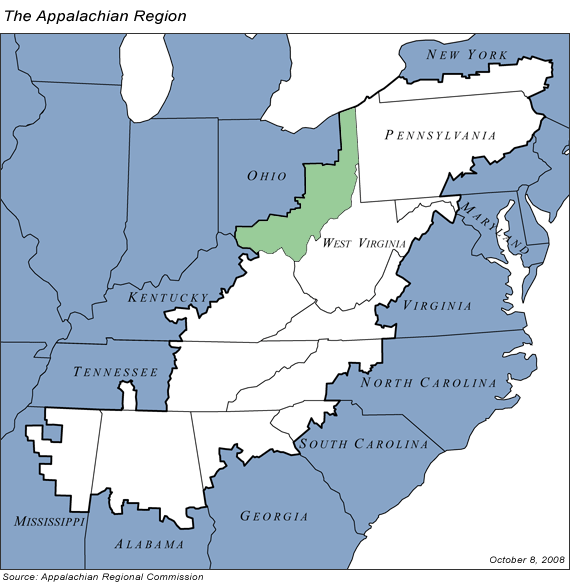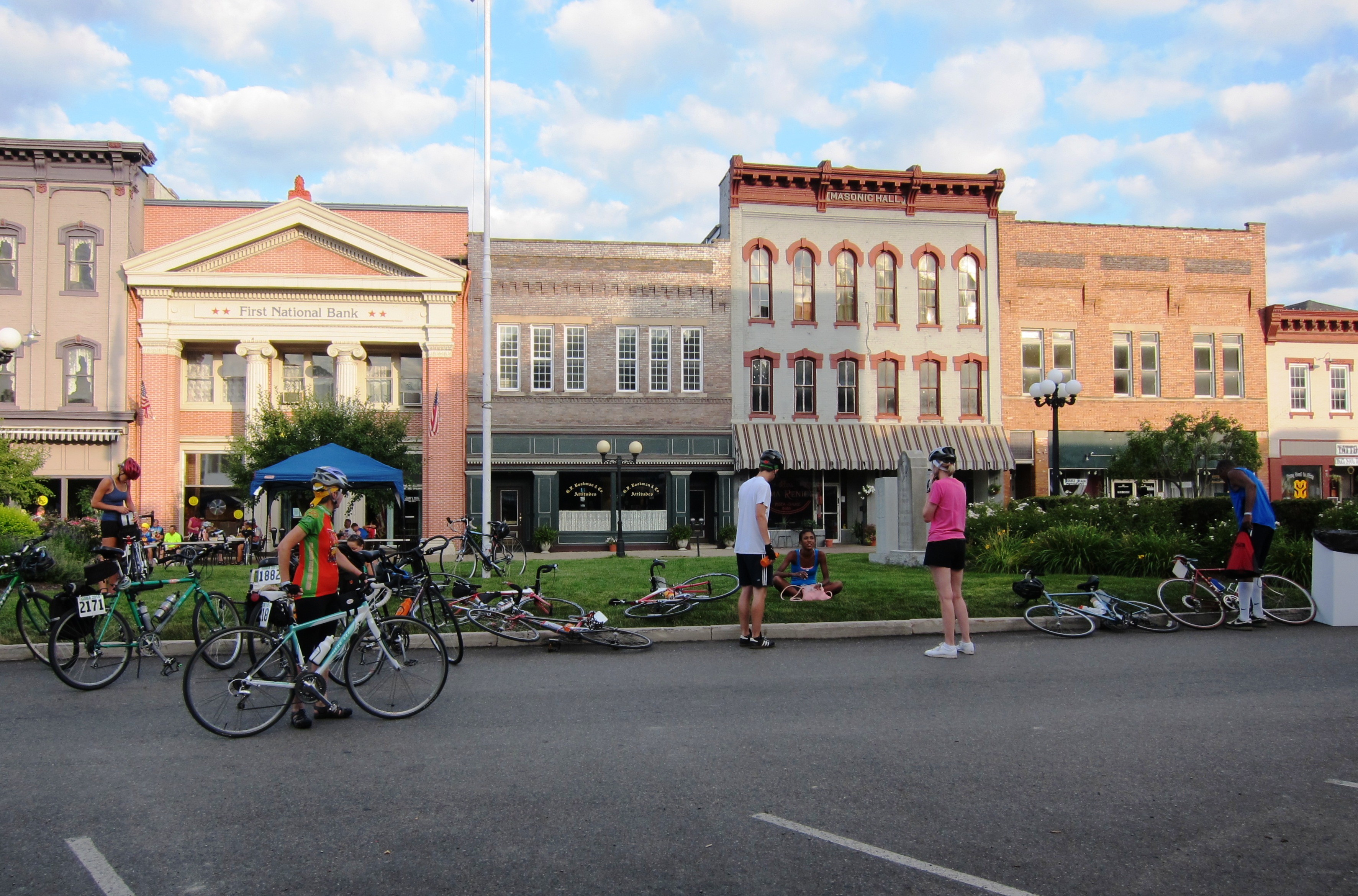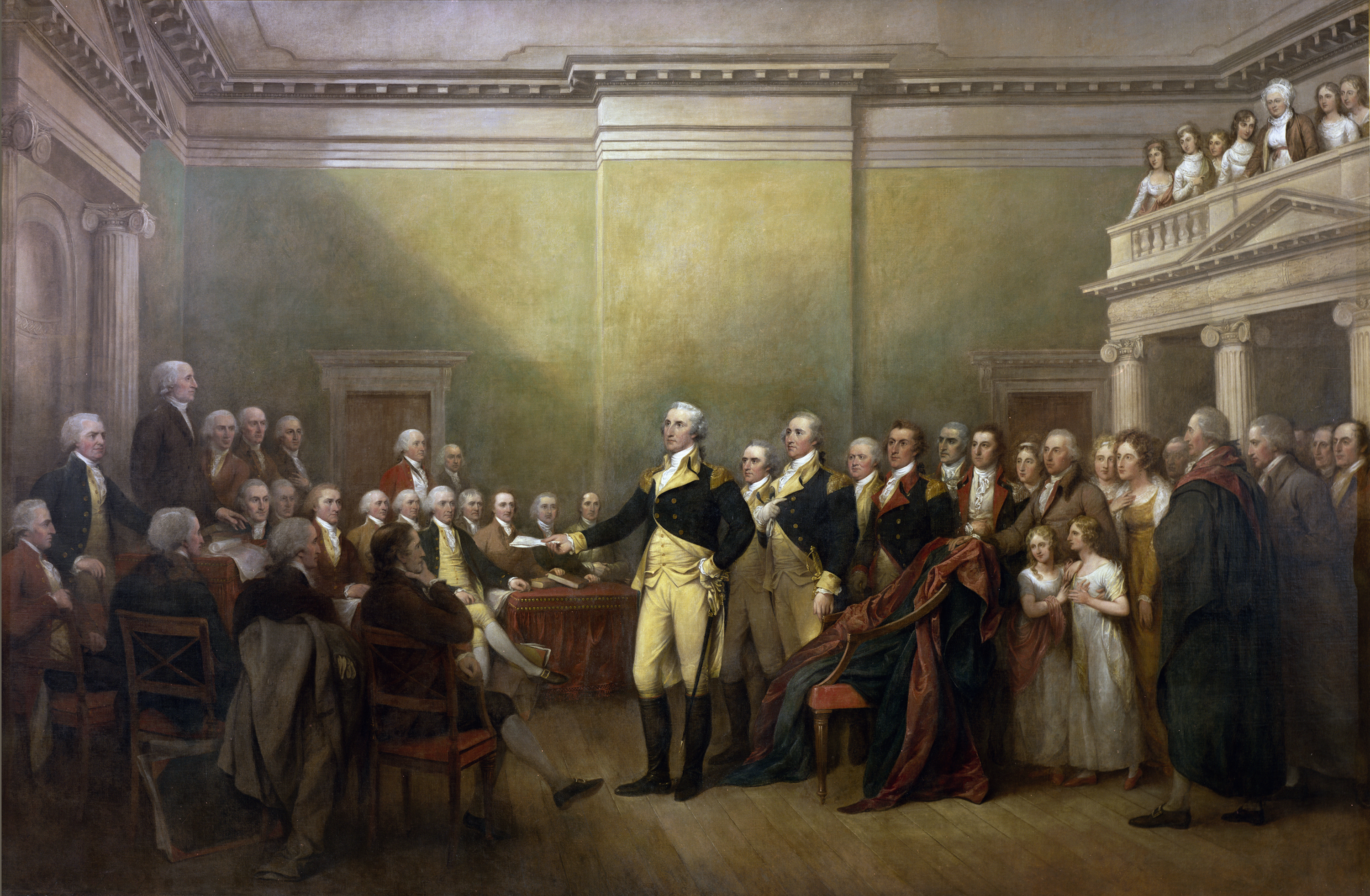|
Athens, Ohio
Athens is a city in Athens County, Ohio, United States, and its county seat. The population was 23,849 at the 2020 United States census. Located along the Hocking River within Appalachian Ohio about southeast of Columbus, Ohio, Columbus, Athens is best known as the home of Ohio University, a large public research university with an undergraduate and graduate enrollment of more than 21,000 students. It is the principal city of the Athens County, Ohio, Athens micropolitan area. History The first permanent European settlers arrived in Athens in 1797, more than a decade after the United States victory in the American Revolutionary War. In 1800, the town site was first surveyed and plotted and incorporated as a village in 1811. Ohio had become a state in 1803. Ohio University was chartered in 1804, the first public institution of higher learning in the Northwest Territory. Previously part of Washington County, Ohio, Athens County was formed in 1805, List of Ohio county name ety ... [...More Info...] [...Related Items...] OR: [Wikipedia] [Google] [Baidu] |
City
A city is a human settlement of a substantial size. The term "city" has different meanings around the world and in some places the settlement can be very small. Even where the term is limited to larger settlements, there is no universally agreed definition of the lower boundary for their size. In a narrower sense, a city can be defined as a permanent and Urban density, densely populated place with administratively defined boundaries whose members work primarily on non-agricultural tasks. Cities generally have extensive systems for housing, transportation, sanitation, Public utilities, utilities, land use, Manufacturing, production of goods, and communication. Their density facilitates interaction between people, government organisations, government organizations, and businesses, sometimes benefiting different parties in the process, such as improving the efficiency of goods and service distribution. Historically, city dwellers have been a small proportion of humanity overall, bu ... [...More Info...] [...Related Items...] OR: [Wikipedia] [Google] [Baidu] |
Appalachian Ohio
Appalachian Ohio is a bioregion and political unit in the southeastern part of the U.S. state of Ohio, characterized by the western foothills of the Appalachian Mountains and the Appalachian Plateau. The Appalachian Regional Commission defines the region as consisting of thirty-two counties."Counties in Appalachia" Appalachian Regional Commission website. Retrieved 2012-Jan-13. This region roughly overlaps with the Appalachian mixed mesophytic forests, Appalachian mixed-mesophytic forests, which begin in southeast Ohio and southwest Pennsylvania and continue south to Georgia (U.S. state), Georgia and Alabama. The mixed-mesophytic forest is found only in Central and Southern Appalachia and eastern/central China. It is one of the most biodiverse temperate forests in the world. Geologically, Appalachian Ohio corresponds closely to the terminal mo ... [...More Info...] [...Related Items...] OR: [Wikipedia] [Google] [Baidu] |
Nelsonville, Ohio
Nelsonville is a city in northwestern Athens County, Ohio, United States, located about southeast of Columbus. The population was 5,373 at the 2020 census. It is home to Hocking College as well as Rocky Brands. Nelsonville is surrounded by Ohio's only national forest, the Wayne National Forest. History First settled in 1814 by the Daniel Nelson, Nelsonville was incorporated in 1838 with Charles Cable as its first mayor. Nelsonville blossomed into a classic Appalachian town by the mid-19th century, relying on the extractive industries of coal, clay and salt. Like many large mining towns, Nelsonville was home to a large hotel, The Dew House, and a thriving theater, Stuart's Opera House, both located on the Public Square. During the American Civil War's famed Morgan's Raid, Confederate cavalry under Brig. Gen. John Hunt Morgan paused in Nelsonville in July 1863 and burned ten wooden canal boats. However, the 400 confederates failed to destroy a covered bridge over th ... [...More Info...] [...Related Items...] OR: [Wikipedia] [Google] [Baidu] |
Hocking Canal
The Hocking Canal, in southeastern Ohio, was a small 19th century lateral/feeder canal of the Ohio-Erie Canal. It began in Carroll, Ohio (which was on the Ohio-Erie Canal) and ran to Athens, Ohio, Athens, Ohio. It paralleled the Hocking River in most places, but also used the river where it was calm and navigable. The portions where the canal route ran in the Hocking River itself were called "slackwater" sections. In 1829, southern Ohio private investors interested in transporting salt and other products to the marketplace faster decided to construct a branch canal from the Ohio and Erie Canal at Carroll, Ohio southward towards Lancaster. Excavation on the "Lancaster lateral" began in 1831. This portion of the canal was completed September 4, 1838. In the same year, the Lancaster Lateral was purchased by the state. Ohio subsequently contracted to extend the canal from Lancaster to Logan, Ohio, Logan, Nelsonville, Ohio, Nelsonville, Chauncey, Ohio, Chauncey and Athens, fifty-thr ... [...More Info...] [...Related Items...] OR: [Wikipedia] [Google] [Baidu] |
Morrill Act
The Morrill Land-Grant Acts are United States statutes that allowed for the creation of land-grant colleges in U.S. states using the proceeds from sales of federally owned land, often obtained from Native American tribes through treaty, cession, or seizure. The Morrill Act of 1862 (12 Stat. 503 (1862) later codified as et seq.) was enacted during the American Civil War, and the Morrill Act of 1890 (the Agricultural College Act of 1890 (, later codified as et seq.)) expanded this model. Passage of original bill Beginning in the 1830s, a political movement called for the creation of agriculture colleges. The movement was led by Professor Jonathan Baldwin Turner of Illinois College. For example, the Michigan Constitution of 1850 called for the creation of an "agricultural school", though it was not until February 12, 1855, that Michigan governor Kinsley S. Bingham signed a bill establishing the United States' first agriculture college, the Agricultural College of the Sta ... [...More Info...] [...Related Items...] OR: [Wikipedia] [Google] [Baidu] |
Ohio Company Of Associates
The Ohio Company of Associates, also known as the Ohio Company, was a land company whose members are today credited with becoming the first non-Native Americans in the United States, Native American group to permanently settle west of the Allegheny mountains. In 1788 they established Marietta, Ohio, as the first permanent settlement of the new United States in the newly organized Northwest Territory.Hubbard, Robert Ernest. ''General Rufus Putnam: George Washington's Chief Military Engineer and the "Father of Ohio,"'' pp. 2–4, 80, McFarland & Company, Inc., Jefferson, North Carolina, 2020. . Creation of the company The company was formed between March 1 and March 3, 1786, by Rufus Putnam, Benjamin Tupper, Samuel Holden Parsons and Manasseh Cutler in Boston, Massachusetts. They had met at The Bunch-of-Grapes tavern, located on King Street, to discuss the settlement of the territory around the Ohio River.Hubbard, Robert Ernest. ''General Rufus Putnam: George Washington's Chie ... [...More Info...] [...Related Items...] OR: [Wikipedia] [Google] [Baidu] |
Congress Of The Confederation
The Congress of the Confederation, or the Confederation Congress, formally referred to as the United States in Congress Assembled, was the governing body of the United States from March 1, 1781, until March 3, 1789, during the Confederation period. A unicameral body with legislative and Executive (government), executive function, it was composed of delegates appointed by the legislatures of the thirteen U.S. state, states. Each state delegation had one vote. The Congress was created by the Articles of Confederation, Articles of Confederation and Perpetual Union upon its ratification in 1781, formally replacing the Second Continental Congress. The Congress continued to refer to itself as the Continental Congress throughout its eight-year history. Modern historians, however, separate it from the two earlier congresses, which operated under slightly different rules and procedures until the end of the American Revolutionary War, Revolutionary War. Membership of the Second Contine ... [...More Info...] [...Related Items...] OR: [Wikipedia] [Google] [Baidu] |
Athens
Athens ( ) is the Capital city, capital and List of cities and towns in Greece, largest city of Greece. A significant coastal urban area in the Mediterranean, Athens is also the capital of the Attica (region), Attica region and is the southernmost capital on the European mainland. With its urban area's population numbering over 3.6 million, it is the List of urban areas in the European Union, eighth-largest urban area in the European Union (EU). The Municipality of Athens (also City of Athens), which constitutes a small administrative unit of the entire urban area, had a population of 643,452 (2021) within its official limits, and a land area of . Athens is one of the List of oldest continuously inhabited cities, world's oldest cities, with its recorded history spanning over 3,400 years, and its earliest human presence beginning somewhere between the 11th and 7th millennia BCE. According to Greek mythology the city was named after Athena, the ancient Greek goddess of wisdom, ... [...More Info...] [...Related Items...] OR: [Wikipedia] [Google] [Baidu] |
List Of Ohio County Name Etymologies
There are 88 counties in the U.S. state of Ohio. Nine of them existed at the time of the Ohio Constitutional Convention in 1802.. Other editions available at anGoogle Books/ref> A tenth county, Wayne, was established on August 15, 1796, and encompassed roughly the present state of Michigan. Other editions available at During the Convention, the county was opposed to statehood, and was not only left out of the Convention, but dissolved; the current Wayne County is in northeastern Ohio, considerably distant from the area that was the original Wayne County. The Ohio Constitution allows counties to set up a charter government as many cities and villages do, (OH county charter). Other editions available: anGoogle Books/ref> but only Summit and Cuyahoga counties have done so, the latter having been approved by voters in November 2009. Counties do not possess home rule powers and can do only what has been expressly authorized by the Ohio General Assembly. The elected county o ... [...More Info...] [...Related Items...] OR: [Wikipedia] [Google] [Baidu] |
Washington County, Ohio
Washington County is a county located in the southeastern part of the U.S. state of Ohio. As of the 2020 census, the population was 59,711. Its county seat is Marietta. The county, the oldest in the state, is named for George Washington. Washington County comprises the Marietta, OH Micropolitan Statistical Area, which is also included in the Parkersburg-Marietta-Vienna, WV-OH Combined Statistical Area. Geography According to the U.S. Census Bureau, the county has a total area of , of which is land and (1.3%) is water. It is the fifth-largest county in Ohio by land area. Washington County's southern and eastern boundary is the Ohio River. The Muskingum River, Little Muskingum River, Duck Creek, and the Little Hocking River flow through the county to the Ohio River. Adjacent counties * Noble County (north) * Monroe County (northeast) * Tyler County, West Virginia (east) * Pleasants County, West Virginia (southeast) * Wood County, West Virginia (south) * Athens ... [...More Info...] [...Related Items...] OR: [Wikipedia] [Google] [Baidu] |
Northwest Territory
The Northwest Territory, also known as the Old Northwest and formally known as the Territory Northwest of the River Ohio, was formed from part of the unorganized western territory of the United States after the American Revolution. Established in 1787 by the Congress of the Confederation through the Northwest Ordinance, it was the nation's first post-colonial Organized incorporated territories of the United States, organized incorporated territory. At the time of its creation, the territory included all the land west of Pennsylvania, northwest of the Ohio River and east of the Mississippi River below the Great Lakes, and what later became known as the Boundary Waters. The region was ceded to the United States in the Treaty of Paris (1783), Treaty of Paris of 1783. Throughout the American Revolutionary War, Revolutionary War, the region was part of the British Province of Quebec (1763–1791), Province of Quebec and the Western theater of the American Revolutionary War, western ... [...More Info...] [...Related Items...] OR: [Wikipedia] [Google] [Baidu] |
American Revolutionary War
The American Revolutionary War (April 19, 1775 – September 3, 1783), also known as the Revolutionary War or American War of Independence, was the armed conflict that comprised the final eight years of the broader American Revolution, in which American Patriot (American Revolution), Patriot forces organized as the Continental Army and commanded by George Washington defeated the British Army during the American Revolutionary War, British Army. The conflict was fought in North America, the Caribbean, and the Atlantic Ocean. The war's outcome seemed uncertain for most of the war. However, Washington and the Continental Army's decisive victory in the Siege of Yorktown in 1781 led King George III and the Kingdom of Great Britain to negotiate an end to the war in the Treaty of Paris (1783), Treaty of Paris two years later, in 1783, in which the British monarchy acknowledged the independence of the Thirteen Colonies, leading to the establishment of the United States as an independent and ... [...More Info...] [...Related Items...] OR: [Wikipedia] [Google] [Baidu] |







